U.S. Dept. of Commerce / NOAA/ OAR / PMEL / Publications
TSUNAMI!
Frank I. González
Pacific Marine Environmental Laboratory, National Oceanic and Atmospheric
Administration, Seattle, Washington
Scientific American, 280, 56–65 (1999)
Copyright ©1999 Scientific American, Inc. All rights reserved. Further electronic
distribution is not allowed.
Its awesome fury cannot be diminished, but lesson learned from
a rash of disasters this decade—and a new way to track these killer waves—will
help save lives.
The sun had set 12 minutes earlier, and twilight was waning on the northern
coast of Papua New Guinea. It was July 17, 1998, and another tranquil Friday
evening was drawing to a close for the men, women and children of Sissano, Arop,
Warapu and other small villages on the peaceful sand spit between Sissano Lagoon
and the Bismarck Sea. But deep in the earth, far beneath the wooden huts of
the unsuspecting villagers, tremendous forces had strained the underlying rock
for years. Now, in the space of minutes, this pent-up energy violently released
as a magni tude 7.1 earthquake. At 6:49 p.m., the main shock rocked 30 kilometers
(nearly 19 miles) of coastline centered on the lagoon and suddenly deformed
the offshore ocean bottom. The normally flat sea surface lurched upward in response,
giving birth to a fearsome tsunami.
Retired Colonel John Sanawe, who lived near the southeast end of the sandbar
at Arop, survived the tsunami and later told his story to Hugh Davies of the
University of Papua New Guinea. Just after the main shock struck only 20 kilometers
offshore, Sanawe saw the sea rise above the horizon and then spray vertically
perhaps 30 meters. Unexpected sounds—first like distant thunder, then like
a nearby helicopter—gradually faded as he watched the sea slowly recede
below the normal low-water mark. After four or five minutes of silence, he heard
a rumble like that of a low-flying jet plane. Sanawe spotted the first tsunami
wave, perhaps three or four meters high. He tried to run home, but the wave
overtook him. A second, larger wave flattened the village and swept him a kilometer
into a mangrove forest on the inland shore of the lagoon.
Other villagers were not so fortunate as Sanawe. Some were swept across the
lagoon and impaled on the broken mangrove branches. Many more were viciously
battered by debris. At least 30 survivors would lose injured limbs to gangrene.
Saltwater crocodiles and wild dogs preyed on the dead before help could arrive,
making it more difficult to arrive at an exact death toll. It now appears that
the tsunami killed more than 2,200 villagers, including more than 230 children.
Waves up to 15 meters high, which struck within 15 minutes of the main shock,
had caught many coastal inhabitants unawares. Of the few villagers who knew
of the tsunami hazard, those trapped on the sandbar simply had no safe place
to flee.
Tsunamis such as those that pounded Papua New Guinea are the world's most powerful
waves. Historical patterns of their occurrence are revealed in large databases
developed by James F. Lander, Patricia A. Lockridge and their colleagues at
the National Geophysical Data Center in Boulder, Colo., and Viacheslav K. Gusiakov
and his associates at the Tsunami Laboratory in Novosibirsk, Russia. Most tsunamis
afflict the Pacific Ocean, and 86 percent of those are the products of undersea
earthquakes around the Pacific Rim, where powerful collisions of tectonic plates
form highly seismic subduction zones.
Larger Wave than Expected
Papua New Guinea
July 17, 1998
Maximum wave height: 15 meters
Fatalities: More than 2,200
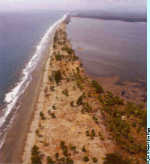 |
Sissano area four days after the
tsunami.
Bare spots mark locations of structures swept away.. |
Swept clean by three monstrous waves, this now barren sandbar along Papua
New Guinea's north coast once was crowded with houses and villages. Suprisingly,
a relatively small earthquake (magnitude 7.1) spawned waves usually limited
to much larger quakes. This apparent discrepancy between earthquake strength
and tsunami intensity has prompted speculation among scientists that the
seismic vibrations may have triggered other seafloor disturbances, such
as an underwater landslide or an explosion of gas hydrates, that helped
to create a much larger tsunami.
Unexpectedly high tsunami waves have caused other disasters, such as
that in Nicaragua in 1992, but intensive surveys of the seafloor to investigate
the mystery have never been conducted until now. Two expeditions explored
the seafloor off the ravaged coast of Papua New Guinea for signs of an
undersea landslide earlier this year. The survey teams, jointly led by
Takeshi Matsumoto of the Japan Marine Science and Technology Center and
David Tappin of the South Pacific Applied Geoscience Commission, identified
a small depression that could be a candidate lanslide site. The next question
is whether this feature is fresh or was created by another earthquake
long ago. -F.G.
|
Since 1990, 10 tsunamis have taken more than 4,000 lives. In all, 82 were reported
worldwide—a rate much higher than the historical average of 57 a decade.
The increase in tsunamis reported is due to improved global communications;
the high death tolls are partly due to increases in coastal populations. My
colleagues and I at the National Oceanic and Atmospheric Administration Pacific
Marine Environmental Laboratory in Seattle set up an electronic-mail network
as a way for researchers in distant parts of the world to help one another make
faster and more accurate tsunami surveys. This Tsunami Bulletin Board, now managed
by the International Tsunami Information Center, has facilitated communication
among tsunami scientists since shortly after the 1992 Nicaragua tsunami [see
box below].
Slow, Silent, Deadly Quake
Nicaragua
September 2, 1992
Maximum wave height: 10 meters
Fatalities: 170
Coastal inhabitants can be educated to run to higher ground when they
feel the land shake from an earthquake. But in certain tragic cases, such
as the 1992 Nicaragua tsunami that killed 170 people and left 13,000 homeless,
residents fell only a minor tremor, or even none at all, and assume there
is no danger. An estimated 5 to 10 percent of tsunami-causing earthquakes
are of this particularly hazardous breed—so-called silent earthquakes,
first described by Hiroo Kanamori of the California Institute of Technology.
In the latest Nicaragua event, the short waves that produce the characteristic
rumbling of an earthquake—and that die out quickly as they spread
out from the epicenter—never made it from the quake's offshore origin
to the mainland. Longer waves did reach the coast, but they hardly shook
the ground. What is more, standard seismometers, which record only seismic
waves with periods less than 20 seconds, missed most of these longer waves.
Kanamori argued that the Nicaragua quake was actually five times greater
than its assigned magnitude of 7.0 because these low-frequency waves had
been ignored. The Nicaragua event made it abundantly clear that broadband
seismometers sensitive to low-frequency waves must be linked to warning
systems to forecast the true potential tsunami danger. -F.G.
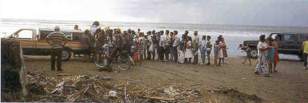 |
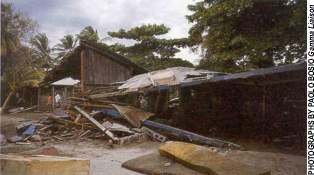 |
| Survivors line up for emergency food supplies |
Coastal village the day after the tsunami |
|
Disasters similar to those in Nicaragua and Papua New Guinea have wreaked havoc
in Hawaii and Alaska in the past, but most tsunami researchers had long believed
that the U.S. West Coast was relatively safe from the most devastating events.
New evidence now suggests that earthquakes may give birth to large tsunamis
every 300 to 700 years along the Cascadia subduction zone, an area off the Pacific
Northwest coast where a crustal plate carrying part of the Pacific Ocean is
diving under North America. A clear reminder of this particular threat occurred
in April 1992, when a magnitude 7.1 earthquake at the southern end of the subduction
zone generated a small tsunami near Cape Mendocino, Calif. This event served
as the wake-up call that has driven the development of the first systematic
national effort to prepare for dangerous tsunamis before they strike. The Pacific
Marine Environmental Laboratory is playing a key research and management role
in this endeavor.
The Physics of Tsunamis
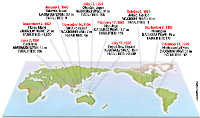 |
| Ten destructive tsunamis have claimed
more than 4,000 lives since 1990. Last year's Papua New
Guinea disaster is the most recent in this string of killer waves generated
by earthquakes along colliding tectonic plates of the Pacific Rim. Also
see Okushiri, Japan and Nicaragua
disasters. |
To understand tsunamis, it is first helpful to distinguish them from wind-generated
waves or tides. Breezes blowing across the ocean crinkle the surface into relatively
short waves that create currents restricted to a shallow layer; a scuba diver,
for example, might easily swim deep enough to find calm water. Strong gales
are able to whip up waves 30 meters or higher in the open ocean, but even these
do not move deep water.
Tides, which sweep around the globe twice a day, do produce currents that reach
the ocean bottom--just as tsunamis do. Unlike true tidal waves, however, tsunamis
are not generated by the gravitational pull of the moon or sun. A tsunami is
produced impulsively by an undersea earthquake or, much less frequently, by
volcanic eruptions, meteorite impacts or underwater landslides. With speeds
that can exceed 700 kilometers per hour in the deep ocean, a tsunami wave could
easily keep pace with a Boeing 747. Despite its high speed, a tsunami is not
dangerous in deep water. A single wave is less than a few meters high, and its
length can extend more than 750 kilometers in the open ocean. This creates a
sea-surface slope so gentle that the wave usually passes unnoticed in deep water.
In fact, the Japanese word tsu-nami translates literally as "harbor wave,"
perhaps because a tsunami can speed silently and undetected across the ocean,
then unexpectedly arise as destructively high waves in shallow coastal waters.
A powerful tsunami also has a very long reach: it can transport destructive
energy from its source to coastlines thousands of kilometers away. Hawaii, because
of its midocean location, is especially vulnerable to such Pacific-wide tsunamis.
Twelve damaging tsunamis have struck Hawaii since 1895. In the most destructive,
159 people died there in 1946 from killer waves generated almost 3,700 kilometers
away in Alaska's Aleutian Islands [see box below]. Such remote-source
tsunamis can strike unexpectedly, but local-source tsunamis—as in the case
of last year's Papua New Guinea disaster—can be especially devastating.
Lander has estimated that more than 90 percent of all fatalities occur within
about 200 kilometers of the source. As an extreme example, it is believed that
a tsunami killed more than 30,000 people within 120 kilometers of the catastrophic
eruption of Krakatoa volcano in the Sunda Straits of Indonesia in 1883. That
explosion generated waves as high as a 12-story building.
Not the First, Not the Last
East Aleutian Islands
April 1, 1946
Maximum wave height: 35 meters
Fatalities: 165
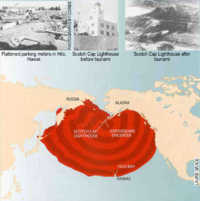 A
rash of tsunamis has struck the Pacific Rim this decade, but destructive
waves have made their mark long before now. Earthquakes along a seismic
subduction zone off Alaska's Aleutian Islands have stirred up the worst
tsunamis in U.S. recorded history. On April 1, 1946, a magnitude 7.8 earthquake
generated a tsunami that wiped out the Scotch Cap Lighthouse in Alaska
and killed five Coast Guard employees. The same tsunami also mad a surprise
attack five hours later on residents of Hilo, Hawaii. There debris-laden
waves up to eight meters high caught a number of schoolchildren before
classes began and wiped out a hospital. Altogether the killer waves took
the lives of 165 people, 159 of them in Hawaii, and caused more than $26
million in damage. A
rash of tsunamis has struck the Pacific Rim this decade, but destructive
waves have made their mark long before now. Earthquakes along a seismic
subduction zone off Alaska's Aleutian Islands have stirred up the worst
tsunamis in U.S. recorded history. On April 1, 1946, a magnitude 7.8 earthquake
generated a tsunami that wiped out the Scotch Cap Lighthouse in Alaska
and killed five Coast Guard employees. The same tsunami also mad a surprise
attack five hours later on residents of Hilo, Hawaii. There debris-laden
waves up to eight meters high caught a number of schoolchildren before
classes began and wiped out a hospital. Altogether the killer waves took
the lives of 165 people, 159 of them in Hawaii, and caused more than $26
million in damage.
The U.S. reacted to this disaster by setting up the Pacific Tsunami Warning
Center in Hawaii in 1948. Similarly, three years after the March 28, 1964,
Alaskan tsunami that took more than 100 lives, the Alaska Regional Tsunami
Warning System (now the West Coast and Alaska Tsunami Warning Center)
was established. Today a newly recognized threat from a seismic zone off
the West Coast has driven the U.S. to take action against a tsunami disaster
before it occurs. This endeavor by state and federal partners features
a systematic tsunami inundation mapping program, a state-of-the-art, deep-ocean
tsunami detection network and educational campaigns to prepare coastal
communities for a potential disaster. -F.G.
|
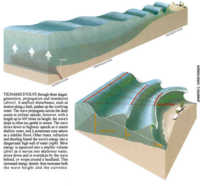 Regardless
of their origin, tsunamis evolve through three overlapping but quite distinct
physical processes: generation by any force that disturbs the water column,
propagation from deeper water near the source to shallow coastal areas and,
finally, inundation of dry land. Of these, the propagation phase is best understood,
whereas generation and inundation are more difficult to model with computer
simulations. Accurate simulations are important in predicting where future remote-source
tsunamis will strike and in guiding disaster surveys and rescue efforts, which
must concentrate their resources on regions believed to be hardest hit.
Regardless
of their origin, tsunamis evolve through three overlapping but quite distinct
physical processes: generation by any force that disturbs the water column,
propagation from deeper water near the source to shallow coastal areas and,
finally, inundation of dry land. Of these, the propagation phase is best understood,
whereas generation and inundation are more difficult to model with computer
simulations. Accurate simulations are important in predicting where future remote-source
tsunamis will strike and in guiding disaster surveys and rescue efforts, which
must concentrate their resources on regions believed to be hardest hit.
Generation is the process by which a seafloor disturbance, such as movement
along a fault, reshapes the sea surface into a tsunami. Modelers assume that
this sea-surface displacement is identical to that of the ocean bottom, but
direct measurements of seafloor motion have never been available (and may never
be). Instead researchers use an idealized model of the quake: they assume that
the crustal plates slip past one another along a simple, rectangular plane inside
the earth. Even then, predicting the tsunami's initial height requires at least
10 descriptive parameters, including the amount of slip on each side of the
imaginary plane and its length and width. As modelers scramble to guide tsunami
survey teams immediately after an earthquake, only the orientation of the assumed
fault plane and the quake's location, magnitude and depth can be interpreted
from the seismic data alone. All other parameters must be estimated. As a consequence,
this first simulation frequently underestimates inundation, sometimes by factors
of 5 or 10.
Low inundation estimates can signify that the initial tsunami height was also
understated because the single-plane fault model distributes seismic energy
over too large an area. Analyses of seismic data cannot resolve energy distribution
patterns any shorter than the seismic waves themselves, which extend for several
hundred kilometers. But long after the tsunami strikes land, modelers can work
backward from records of run-up and additional earthquake data to refine the
tsunami's initial height. For example, months of aftershocks eventually reveal
patterns of seismic energy that are concentrated in regions much smaller than
the original, single-plane fault model assumed. When seismic energy is focused
in a smaller area, the vertical motion of the seafloor—and therefore the
initial tsunami height—is greater. Satisfactory simulations are achieved
only after months of labor-intensive work, but every simulation that matches
the real disaster improves scientists' ability to make better predictions.
Propagation of the tsunami transports seismic energy away from the earthquake
site through undulations of the water, just as shaking moves the energy through
the earth. At this point, the wave height is so small compared with both the
wavelength and the water depth that researchers apply linear wave theory, which
assumes that the height itself does not affect the wave's behavior. The theory
predicts that the deeper the water and the longer the wave, the faster the tsunami.
This dependence of wave speed on water depth means that refraction by bumps
and grooves on the seafloor can shift the wave's direction, especially as it
travels into shallow water. In particular, wave fronts tend to align parallel
to the shoreline so that they wrap around a protruding headland before smashing
into it with greatly focused incident energy. At the same time, each individual
wave must also slow down because of the decreasing water depth, so they begin
to overtake one another, decreasing the distance between them in a process called
shoaling. Refraction and shoaling squeeze the same amount of energy into a smaller
volume of water, creating higher waves and faster currents.
The last stage of evolution, inundation and run-up, in which a tsunami may
run ashore as a breaking wave, a wall of water or a tidelike flood, is perhaps
the most difficult to model. The wave height is now so large that linear theory
fails to describe the complicated interaction between the water and the shoreline.
Vertical run-up can reach tens of meters, but it typically takes only two to
three meters to cause damage. Horizontal inundation, if unimpeded by coastal
cliffs or other steep topography, can penetrate hundreds of meters inland. Both
kinds of flooding are aided and abetted by the typical crustal displacement
of a subduction zone earthquake, which lifts the offshore ocean bottom and lowers
the land along the coast. This type of displacement propagates waves seaward
with a leading crest and landward with a leading trough (the reason a receding
sea sometimes precedes a tsunami). Not only does the near-shore subsidence facilitate
tsunami penetration inland but, according to recent studies by Raissa Mazova
of the Nizhny Novgorod State Technical University in Russia and by Costas Synolakis
of the University of Southern California, both theoretical predictions and field
surveys indicate that coastal run-up and inundation will be greater if the trough
of the leading wave precedes the crest.
Tsunami Threats
Predicting where a tsunami may strike helps to save lives and property only
if coastal inhabitants recognize the threat and respond appropriately. More
than a quarter of all reliably reported Pacific tsunamis since 1895 originated
near Japan. This is not surprising, because Japan is precariously situated near
the colliding margins of four tectonic plates. Recognizing the recurring threat,
the Japanese have invested heavily over the years in tsunami hazard mitigation,
including comprehensive educational and public outreach programs, an effective
warning system, shoreline barrier forests, seawalls and other coastal fortifications.
On the night of July 12, 1993, their preparations faced a brutal test. A magnitude
7.8 earthquake in the Sea of Japan generated a tsunami that struck various parts
of the small island of Okushiri [see box below]. Five minutes after the
main shock the Japan Meteorological Agency issued a warning over television
and radio that a major tsunami was on its way. By then, 10- to 20-meter waves
had struck the coastline nearest the source, claiming a number of victims before
they could flee. In Aonae, a small fishing village on the island's southern
peninsula, many of the 1,600 townspeople fled to high ground as soon as they
felt the main shock. A few minutes later tsunami waves five to 10 meters high
ravaged hundreds of their homes and businesses and swept them out to sea. More
than 200 lives were lost in this disaster, but quick response saved many more.
Education Saves Lives
Okushiri, Japan
July 12, 1993
Maximum wave height: 31 meters
Fatalities: 239
Fires burned across the ravaged shores of Aonae, a small fishing village
on Okushiri's southern peninsula, in the wake of the 1993 tsunami. Waes
ranging from 5 to 10 meters had crashed ashore less than five minutes
after the magnitude 7.8 earthquake struck perhaps 15 to 30 kilometers
offshore in the Sea of Japan. The waves washed over seawalls erected after
past tsunami disasters. High currents swept up buildings, vehicles, docked
vessels and heavy material at coastal storage areas, transforming them
into waterborne battering rams that obliterated all in their path. Collisions
sparked electrical and propane gas fires, but access by fire engines was
blocked by debris.
The loss of lives in this event was a great tragedy, but it is clear
that both warning technology and community education greatly reduced the
number of casualties. The Japan Meteorological Agency issued timely and
accurate warnings, and many residents saved themselves by fleeing to higher
ground immediately after the main shock—even before the warning.
Okushiri clearly demonstrated that the impact of tsunamis can be reduced.
This event has also become the best-documented tsunami disaster in history.
Detailed damage assessments of transportation and telecommunications networks,
interviews with survivors and local officials, run-up and inundation measurements,
and extensive aerial photography produced a database especially valuable
to the U.S.: this urban township is a better analogue of U.S. coastal
communities than the other, less developed areas destroyed by tsunamis
this decade. -F.G.
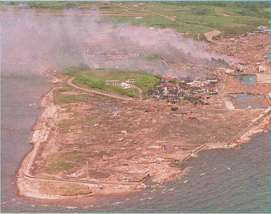 |
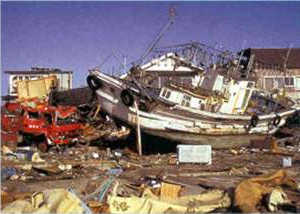 |
Fires and denuded peninsula in wake of the tsunami |
Damaged fire truck amid the debris |
|
Over the past century in Japan, approximately 15 percent of 150 tsunamis were
damaging or fatal. That track record is much better than the tally in countries
with few or no community education programs in place. For example, more than
half of the 34 tsunamis that struck Indonesia in the past 100 years were damaging
or fatal. Interviews conducted after the 1992 Flores Island tsunami that killed
more than 1,000 people indicated that most coastal residents did not recognize
the earthquake as the natural warning of a possible tsunami and did not flee
inland. Similarly, Papua New Guinea residents were tragically uninformed, sending
the number of casualties from last year's disaster higher than expected for
a tsunami of that size. A large quake in 1907 evidently lowered the area that
is now Sissano Lagoon, but any resulting tsunami was too small and too long
ago to imprint a community memory. When the earthquake struck last year, some
people actually walked to the coast to investigate the disturbance, thus sealing
their fate.
Scientists have learned a great deal from recent tsunamis, but centuries-old
waves continue to yield valuable insights. Lander and his colleagues have described
more than 200 tsunamis known to have affected the U.S. since the time of the
first written records in Alaska and the Caribbean during the early 1700s and
in Hawaii and along the West Coast later that century. Total damage is estimated
at half a billion dollars and 470 casualties, primarily in Alaska and Hawaii.
An immediate threat to those states and the West Coast is the Alaska-Aleutian
subduction zone. Included in this region's history of large, tsunami-generating
earthquakes are two disasters that drove the establishment of the country's
only two tsunami warning centers. The probability of a magnitude 7.4 or greater
earthquake occurring somewhere in this zone before 2008 is estimated to be 84
percent.
Another major threat, unrevealed by the written records, lurks off the coasts
of Washington State, Oregon and northern California—the Cascadia subduction
zone. Brian F. Atwater of the U.S. Geological Survey has identified sand and
gravel deposits that he hypothesized were carried inland from the Washington
coast by tsunamis born of Cascadia quakes. Recent events support this theory.
The Nicaragua tsunami was notable for the amount of sand it transported inland,
and researchers have documented similar deposits at inundation sites in Flores,
Okushiri, Papua New Guinea and elsewhere.
At least one segment of the Cascadia subduction zone may be approaching the
end of a seismic cycle that culminates in an earthquake and destructive tsunami
[see "Giant Earthquakes of the Pacific Northwest," by Roy D. Hyndman; Scientific
American, December 1995]. The earthquake danger is believed to be comparable
to that in southern California—about a 35 percent probability of occurrence
before 2045. Finally, the 1992 Cape Mendocino earthquake and tsunami was a clear
reminder that the Cascadia subduction zone can unleash local tsunamis that strike
the coast within minutes.
Getting Ready in the U.S.
 |
| Community education is crucial to the
recent U.S. push to avoid future tsunami disasters. Signs, standardized
for all Pacific states, now alert coastal dwellers and visitors to tsunami-prone
areas. |
Hard on the heels of the surprising Cape Mendocino tsunami, the Federal Emergency
Management Agency (FEMA) and NOAA funded an earthquake scenario study of northern
California and the production of tsunami inundation maps for Eureka and Crescent
City in that state. The resulting "all hazards" map was the first of its kind
for the U.S. It delineates areas susceptible to tsunami flooding, earthquake-shaking
intensity, liquefaction and landslides. Researchers then tackled the possible
effects of a great Cascadia subduction zone earthquake and tsunami. About 300,000
people live or work in nearby coastal regions, and at least as many tourists
travel through these areas every year. Local tsunami waves could strike communities
within minutes of a big quake, leaving little or no time to issue formal warnings.
What is more, a Cascadia-born tsunami disaster could cost the region between
$1.25 billion and $6.25 billion, a conservative estimate considering the 1993
Okushiri disaster.
Clarification of the threat from the Cascadia subduction zone and the many
well-reported tsunami disasters of this decade have stimulated a systematic
effort to examine the tsunami hazard in the U.S. In 1997 Congress provided $2.3
million to establish the National Tsunami Hazard Mitigation Program. Alaska,
California, Hawaii, Oregon and Washington formed a partnership with NOAA, FEMA
and the USGS to tackle the threat of both local- and remote-source tsunamis.
The partnership focuses on three interlocking activities: assessing the threat
to specific coastal areas; improving early detection of tsunamis and their potential
danger; and educating communities to ensure an appropriate response when a tsunami
strikes.
The threat to specific coastal areas can be assessed by means of tsunami inundation
maps such as those designed for Eureka and Crescent City using state-of-the-art
computer modeling. These maps provide critical guidance to local emergency planners
charged with identifying evacuation routes. Only Hawaii has systematically developed
such maps over the years. To date, three Oregon communities have received maps,
six additional maps are in progress in Oregon, Washington and California, and
three maps are planned for Alaska.
Rapid, reliable confirmation of the existence of a potentially dangerous tsunami
is essential to officials responsible for sounding alarms. Coastal tide gauges
have been specially modified to measure tsunamis, and a major upgrade of the
seismic network will soon provide more rapid and more complete reports on the
nature of the earthquake. These instruments are essential to the warning system,
but seismometers measure earthquakes, not tsunamis. And although tide gauges
spot tsunamis close to shore, they cannot measure tsunami energy propagating
toward a distant coastline. As a consequence, an unacceptable 75 percent false-alarm
rate has prevailed since the 1950s. These incidents are expensive, undermine
the credibility of the warning system, and place citizens at risk during the
evacuation. A false alarm that triggered the evacuation of Honolulu on May 7,
1986, cost Hawaii more than $30 million in lost salaries and business revenues.
 |
| Deep-ocean tsunami detectors (left)
and a major upgrade of existing earthquake monitoring networks (blue
triangles on map)—both scheduled for installation within two years—lead
the U.S. effort to take the surprise out of tsunami attacks. The deep-ocean
detectors depend on high-tech sensors stationed on the seafloor. When one
of these instruments senses a tsunami wave overhead, it will send acoustic
signals to a buoy at the surface, such as the one being launched in the
photograph, which will then relay the warning via satellite to the officials
who are responsible for sounding an alarm. |
NOAA is therefore developing a network of six deep-ocean reporting stations
that can track tsunamis and report them in real time, a project known as Deep-Ocean
Assessment and Reporting of Tsunamis (DART). Scientists have completed testing
of prototype systems and expect the network to be operating reliably in two
years. The rationale for this type of warning system is simple: if an earthquake
strikes off the coast of Alaska while you're lying on a Hawaiian beach, what
you really want to have between you and the quake's epicenter is a DART system.
Here's why:
Seismometers staked out around the Pacific Rim can almost instantly pinpoint
a big Alaskan quake's location. In the next moment, complex computer programs
can predict how long a triggered tsunami would take to reach Hawaii, even though
there is not yet evidence a wave exists. After some minutes, tide gauges scattered
along the coastlines may detect a tsunami. But the only way to be sure whether
a dangerous wave is headed toward a distant coast is to place tsunami detectors
in its path and track it across the open ocean.
Conceptually, the idea of such a real-time reporting network is straightforward;
however, formidable technological and logistical challenges have held up implementation
until now. The DART systems depend on bottom pressure recorders that Hugh B.
Milburn, Alex Nakamura, Eddie N. Bernard and I have been perfecting over the
past decade at the Pacific Marine Environmental Laboratory. As the crest of
a tsunami wave passes by, the bottom recorder detects the increased pressure
from the additional volume of overlying water. Even 6,000 meters deep, the sensitive
instrument can detect a tsunami no higher than a single centimeter. Ship and
storm waves are not detected, because their length is short and, as with currents,
changes in pressure are not transmitted all the way to the ocean bottom. We
placed the first recorders on the north Pacific seafloor in 1986 and have been
using them to record tsunamis ever since. The records cannot be accessed, however,
until the instruments are retrieved.
Ideally, when the bottom recorders detect a tsunami, acoustic chirps will transmit
the measurements to a car-size buoy at the ocean surface, which will then relay
the information to a ground station via satellite. The surface buoy systems,
the satellite relay technology and the bottom recorders have proved themselves
at numerous deep-ocean stations, including an array of 70 weather buoys set
up along the equator to track El Niño, the oceanographic phenomenon so infamous
for its effect on world climate. The biggest challenge has been developing a
reliable acoustic transmission system. Over the past three years, four prototype
DART systems have been deployed, worked for a time, then failed. Design improvements
to a second-generation system have refined communication between the bottom
recorders and the buoys.
In the next two years, our laboratory plans to establish five stations spread
across the north Pacific from the west Aleutians to Oregon and a sixth sited
on the equator to intercept tsunamis generated off South America. More buoys
would reduce the possibility that tsunami waves might sneak between them, but
the current budget limits the number that NOAA can afford. This is where detailed
computer simulations become invaluable. Combined with the buoy measurements,
the simulations will provide more accurate predictions to guide officials who
may have only a few minutes to decide whether to sound an alarm.
Even the most reliable warning is ineffective if people do not respond appropriately.
Community education is thus perhaps the most important aspect of the national
mitigation program's threefold mission. Each state is identifying coordinators
who will provide information and guidance to community emergency managers during
tsunami disasters. Interstate coordination is also crucial to public safety
because U.S. citizens are highly mobile, and procedures must be compatible from
state to state. Standard tsunami signage has already been put in place along
many coastlines.
Tsunami researchers and emergency response officials agree that future destructive
tsunamis are inevitable and technology alone cannot save lives. Coastal inhabitants
must be able to recognize the signs of a possible tsunami—such as strong,
prolonged ground shaking—and know that they should seek higher ground immediately.
Coastal communities need inundation maps that identify far in advance what areas
are likely to be flooded so that they can lay out evacuation routes. The proactive
enterprise now under way in the U.S. will surely upgrade tsunami prediction
for a much larger region of the Pacific. All of these efforts are essential
to the overriding goal of avoiding tragedies such as those in Papua New Guinea,
Nicaragua and elsewhere.
The Author. Frank I. González is Tsunami Research Program Leader
and Director of the Center for Tsunami Inundation Mapping Efforts at NOAA's
Pacific Marine Environmental Laboratory in Seattle. He earned his Ph.D. in physical
oceanography from the University of Hawaii in 1975 and joined the laboratory
two years later. In 1984 he received NOAA's highest award for outstanding scientific
research—the NOAA Administrator's Award—for his work on hazardous
ocean waves. He has participated in field surveys and documentation of three
devastating tsunamis that recently occurred in Nicaragua, Indonesia and Japan.
The author dedicates this article to the memory of his wife, Yolanda Cano González.
In his words: "Yolanda was well known by many in the tsunami research community.
She was a gifted, award-winning teacher who loved children, gardening, science
and, wonderfully, me. As she loved and nurtured her gardens, Yolanda loved and
nurtured her students and their enthusiasm for science."
Further Reading
United States Tsunamis (Including United States Possessions): 1690–1988.
James F. Lander and Patricia A. Lockridge, NOAA/National Geophysical Data Center,
Publication 41–42, 1989.
The Cape Mendocino Tsunami. F. I. González and E. N. Bernard in Earthquakes
and Volcanoes, Vol. 23, No. 3, pages 135–138; 1992.
Tsunami! Walter C. Dudley and Min Lee. University of Hawaii Press, 1998.
Additional information on tsunamis can be found at http://www.pmel.noaa.gov/tsunami/
on the World Wide Web.
PMEL Outstanding Papers
PMEL Publications Search
PMEL Homepage









